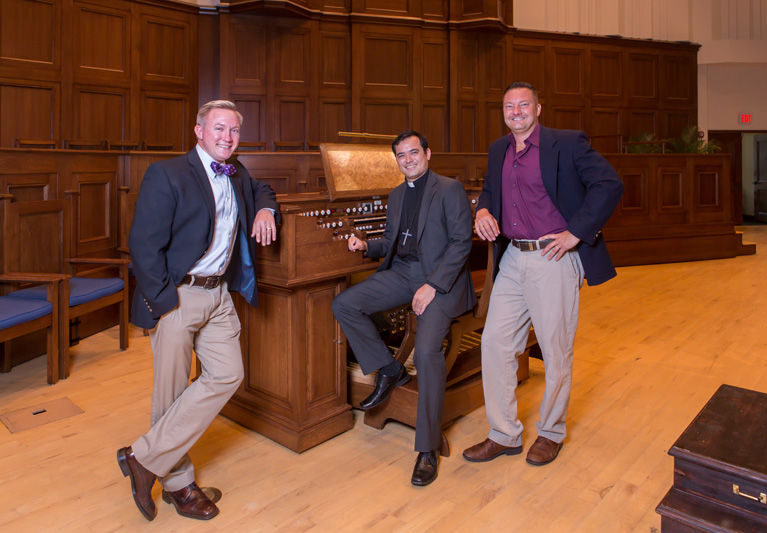
Thirty years after voices first rang out in unison as the Vero Beach Choral Society, the group has returned to Community Church, its founding home, with the hope of reestablishing its original inclusiveness and expanding its role in Vero’s music scene.
With a schedule that includes collaborations with Vero Beach Opera as well as with young voices from the public school system, the choral society will perform as part of Community Church’s concert series.
The 40-member chamber choir will now become one of Community’s ensembles in residence. That means the church, the largest in Vero Beach, will lend its marketing and publicity help to bringing in audiences as well as singers.
“It’s a new phase,” says the group’s enthused director, Jason Hobratschk. “It’s the next 30 years. We’re looking forward to a pretty adventuresome program schedule.”
That schedule includes Gabriel Fauré’s ”Requiem,” for which the children in the choral program of Rosewood Elementary will be training to join the adult singers.
“The Choral Society has always had a very strong educational aspect,” says the group’s president, the Rev. Berek Smith, a curate at St. Augustine of Canterbury Episcopal Church.
Last season, the Choral Society included the Indian River Charter High School chorus in its spring concert. That concert was guest-conducted by Ray Adams, artistic director of Charter High’s performing arts academy and the founding director of Vero Beach Choral Society.
In the upcoming season, the Choral Society will serve as the chorus in Vero Beach Opera’s contemporary, English-language production of Johann Strauss II’s “Die Fledermaus,” slated for mid-January. The opera company is also using Ballet Vero Beach to stage the dance sequences in the opera, to be held at Vero Beach High School’s Performing Arts Center.
“It’s fun music, it’s not complicated,” says the opera’s artistic director, Roman Ortega-Cowan.
The Choral Society’s members will sing alongside voices from Charter High and Stetson University.
It was Smith who approached Vero Beach Opera this summer, interested in expanding the breadth of the singing group’s experience.
“We reviewed their recent work on YouTube and we felt it has risen to a level that we feel it’s time for us to take a look at them very seriously,” says Ortega-Cowan.
He recalls only one other time the Choral Society sang with the opera, in a concert with Met soprano Susan Neves. It was soon after the 2004 hurricanes that left the opera without a home, and Community Church opened its doors for the opera society’s concert.
“The sound composition of the group now that they have mixed ages, that’s of interest to us,” says Ortega-Cowan.
As for the chorus’s return to Community Church, Hobratschk was a key player in a literal round of musical chairs that brought the group full circle.
Hobratschk, a Fulbright scholar with a doctorate in musicology from Florida State University, resigned as organist and choirmaster at Trinity Episcopal Church, a post he has held since 2010. Hobratschk says he is leaving for personal reasons.
He now serves as Community Church’s choral section leader and assistant to Ryan Kasten, who earlier this year was named Community’s music director. (Kasten’s newly hired associate music director, Justin Maxey, arrives later this month from the Eastman School of Music.)
Meanwhile, Ray Adams, who founded the Vero Beach Choral Society when he was music director at Community Church, is taking over for Hobratschk at Trinity until that church finds a permanent music director. That should occur sometime in January, says Trinity’s Father Chris Rodriguez.
It was the Choral Society board that decided to leave Trinity after Hobratschk’s departure. A clause in a written agreement with Trinity states that if Hobratschk left his post at the church, the choral group could depart as well.
Smith said his group’s board voted to move back to Community. Hobratschk will temporarily be working as head choral section leader at the church as well as assistant to Ryan Kasten, Community’s music director.
As for singers interested in joining the newly relocated choir, Hobratschk urges them to come watch a rehearsal.
“Anyone can sing in a choir if you work with them,” he says. “It takes a lot of time to do that sometimes, but that’s the joy.”
Auditions are Sept. 14 and 21, held in conjunction with the chorus’s normal practice days, Monday at 7 p.m., so that prospective singers can observe. In keeping with the Choral Society’s effort to embrace all singers, the auditions are to test only basic musicianship.
Nevertheless, Smith, Kasten and Hobratschk acknowledge how anxious newcomers may feel.
“Singing is always especially difficult, more so even than playing an instrument because the voice is part of your body. It’s very easy to take it very personally,” says Hobratschk.
Auditioning is nerve-wracking “no matter how professional or how much training you have,” says Smith, who has sung counter-tenor since the age of 15, when he joined a large community choir in his hometown of Tokyo. “If we have to do an audition, we’re as terrified as anyone.”



